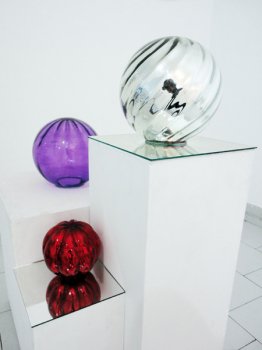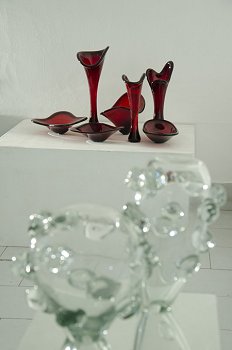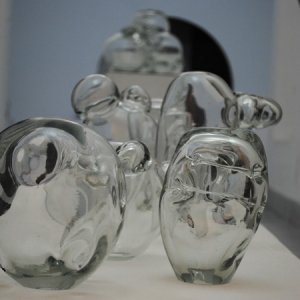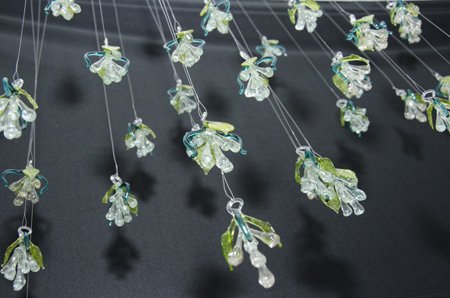
|   |

|   |
An exhibition of Glass Art - Padma Jayaraj, Thrissur e-mail: padmajayaraj@gmail.com March 19, 2012 We, in India, do not have the tradition of glass art. Legend has it that glass was accidentally discovered while Roman seamen were cooking their evening meal on the seashore. The first metal blow pipe came into use in the 1st century BC in Mesopotamia. And later glass production soared in the Roman world. Then with the rise of the Islamic world, glass art rose to new heights. Throughout history, glass art ebbed and flowed with the rise and fall of kingdoms. The Italian Renaissance saw Venice and Murano become centers of gossamer creations. Even now artists prefer to go to Murano to learn. Ginto Joseph, a student of Fine Arts College, Thrissur, is a post graduate in ceramics and glass design from National Institute of Design, Ahmedabad. He nurtures a passion for a profound creative exploration with glass. He is one of the few pioneers in India to explore this medium. He has attended many camps and has participated in group shows. He has designed various industrial projects and is currently working as a Product Designer at Helios Packaging Studio, Delhi. He is passionate about Art, Design and Craft. The Finer Breed, an exhibition of glass works by Ginto Joseph in the Art Gallery of Kerala Lalitkala Akademi, Thrissur (Feb 22 to 28, 2012) was a sculptural statement designed in avant-garde style. Few artists, in India, have tried this medium for artistic statements. We as spectators are more familiar with its functional uses. Of course art objects in blown glass adorn museums in the metros. The exhibition was notable for its statement as well as for its aesthetics. Tired of watching activists using the medium of art to provoke and shock, this exhibition breathed in fresh air. Its aesthetics gently prevailed to dwell on philosophical questions.    The gallery greets you with the abstracts of a couple, reminiscent of humans, but mutated in form. Transparent blown glass art work with colours giving it an aesthetic dimension, arrests you on the very first step of the staircase. These hollow beings are the tone and tenor of the entire show. On the next stop, up, are balls that remind you of fruits, fruits conceived by the artist, yet replica of fruits in nature. Luster coating has made them multicolored things of beauty: silver, gold and of many soft hues, evoking joy. Apparently, plants that multiply in deserts showcase nature’s strength to fight the forces of adversity. The artist has suggested it by exploiting the curatorial practice of using shining planes of reflection to display the assemblage. The theme of nature, hand in hand with artistry, leads the way for you. Ginto stops to explain the technique of blowing glass to make an object of art. Glass blowing is a technique that involves inflating molten glass into a bubble using a blowpipe. The technology exploits a working property of glass: inflation. A molten blob of glass is inflated by introducing a small amount of air in to it. Molten glass is viscous enough to be blown and shaped using tools with hand and gradually hardens as it loses heat. Slumping and fusing are other methods to create the desired shapes. Technology interferes by giving the structure of balloon as the basic constitution of his works. At the same time glass has an innate decorative aspect as it plays with light. When curated with imagination, an exhibition acquires aesthetic dimensions. His next group put on show was a group of table ware in colored glass reminiscent of pieces displayed in museums. Table wares of different colors and designs are more of home décor pieces. For mold glass, the artist makes a mold out of sand or plaster and silica which can be filled with either clear glass or colored or patterned glass, depending on the techniques and effects desired. Up above is a cluster of three ball-like spheres that showcase magical realism. The small red colored melon like fruit, seems dull, but looking closer you find seeds navigating in its liquid womb: the magic of creation! What is man to tamper with such mystery? The bigger transparent violet ball looks like a balloon that children fly up filling it with rarified gas. Contrasting both is another silvery sphere that creates the illusion of speedy movement. Placed on a shining, mirror like surface, reflections come from untold angles. With distorted images, the refraction creates a world of illusions. You feel the stuff with which dreams are made of. Was this the replica of the Earth revolving at break neck speed in interstellar space that astronauts watched from on a moon lit night? The sculptures, each distinct and different from one another, invite you. Here are two headless crawlers, our fellow beings, mutated version of the meanest creatures that tell you of beauty, of life, and their right to a place of their own. Shouldn’t we give them the sacred space of their birth right? What use of chemicals, in the name of more production can ever justify the ways of man.   Then on, mutation runs riot -fruits have cancerous lumps; tumors distort shapes. Twenty six glass structures of unwanted bulges and juts represent plants that would sprout in bizarre shapes in future. The mystic number 3 dominates: each unit disparate in size and shape is linked by 3 giving a metaphysical touch to the show. It is as if hope lurked somewhere. The grand piece at the end is as beautiful as the showers that rain joy, or the hanging flowers that cast a shy glance or the stars that adorn the horizons. Like icicles frozen on a green leafy branch on a winter morning, they gleam. The decorative aspect of glass as the material, with design aesthetic in dimension, the artist evokes nature in all her enchantment. The droplets move in silent dance in rhythmic steps to your heartbeat. How beautiful she can be even in mutation, these formless forms, and shapeless shapes is a lyric in another lingo that communes at another level. Padma Jayaraj is a freelance writer and a regular contributor to narthaki.com |